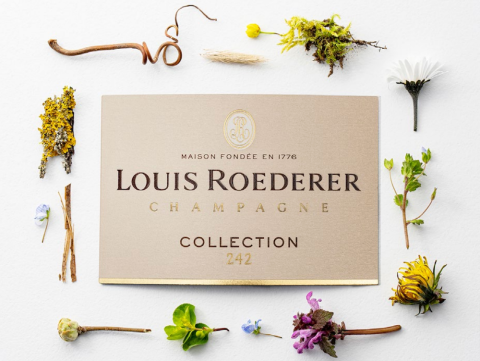From €37, HK$320, 42 Swiss francs, $44.99, NZ$99, 319 Danish kroner, 469 Swedish kronor, £38.99, 5,400 Japanese yen, SG$72, 499.90 Norwegian kroner, AU$77.95, 1,399 Czech koruna, 2,160 Taiwan dollars, 2,360 Ukrainian hryvnia, 6,684 roubles
Non-vintage cuvées of champagne were the masterstroke. In a marginal climate where harvest quality was highly variable, blending across multiple vintages allowed producers to release a wine that tasted the same every year.
Not only did this allow brands to maintain a consistent price, it solved the supply-chain problem of selling superannuated stock and also allowed production volumes to increase, effectively without limit.
Steering away from such an advantageous model might seem bad for business, but Champagne Louis Roederer has made a compelling case in the shape of its new non-vintage blend, Collection 242.
There are two salient points to glean from coverage of the UK launch of Collection 242 earlier this year.
The first is that the prompt for this new blend was climate change. 'Anticipating future seasons and adapting to the present are our ongoing challenges', according to the Collection 242 leaflet. 'To further enhance the freshness' – which for Champagne always meant harvesting underripe grapes – 'and to balance the superb maturity of the harvested grapes, we have created a "Perpetual Reserve".' In other words, they utilise a solera-style blend to offset increasingly ripe harvests.
The second point is that the recommended retail price increased by almost 10%.
Whether price increases or climate change seems more salient is beside the point. Most important is whether the quality holds up to scrutiny. Here, Roederer has an impeccable track record: throughout their range, from non-vintage up to luxury cuvée, Roederer consistently produce excellent champagne across a range of styles.
Jancis has twice awarded 17/20 to the Collection 242, noting deep flavours, completeness, personality, beautiful balance, evolution and richness. When I tasted it recently at a tasting held by its Singapore importer Grand Vin, I very much enjoyed the baked-apple and rich dairy scents that are the markers of classic champagne, although thought it was relatively light in autolysis (the yeasty character of bottle maturation).
It is not necessarily better than its predecessor, Brut Premier NV, but nor is it supposed to be. Instead, it is meant to be a more sustainable version at a concomitantly higher price, although the actual market price is lower than the putative RRP of £52. Regardless, Collection 242 continues Roederer's reputation for delivering excellent, classic champagne – with a clean conscience.
Comparing the cuvées
Collection 242 is not the first release of this new era. Collection 241 was the first to be sold commercially, and is still available in magnum. Roederer disclose full details of how each blend is constructed, allowing us to compare the two.
Collection 241:
- 42% Pinot Noir, 40% Chardonnay, 18% Meunier
- Reserve wines aged in oak: 10% from 2011, 2012, 2013, 2014, 2015
- Perpetual-reserve wines: 34% from 2012, 2013, 2014, 2015
- 56% from 2016
- Lees ageing: 4 years
- Dosage: 8 g/l
- Malolactic conversion of 30% of the blend
Collection 242:
- 36% Pinot Noir, 42% Chardonnay, 22% Meunier
- Reserve wines aged in oak: 10% from 2009, 2011, 2013, 2014, 2015 and 2016
- Perpetual-reserve wines: 34% from 2012, 2013, 2014, 2015 and 2016
- 56% from 2017
- Lees ageing: 3 years
- Dosage: 8 g/l
- Malolactic conversion of 34% of the blend
Both releases look similar on many criteria. The slight variation of varietal proportions is unlikely to make an appreciable difference. Both contain 10% and 34% respectively of reserve wines from cask and perpetual-reserve wines from tank. Dosage is the same, while the difference in the percentage of malolactic conversion is negligible.
The big difference comes from the bulk of the blend: 241 is mostly composed of the 2016 vintage (Roederer's 241st harvest), while 242 contains the same percentage of 2017. The former vintage was much better in Champagne, so you might expect the 242 to have required more reserve wine in the blend to assuage any shortcomings. Then again, the whole point of releasing different cuvées each year is to emphasise rather than obscure differences.
It will be interesting to see if subsequent releases follow the same proportions. In the meantime, the only way to compare 241 and 242 is by stocking up on both and tasting them as frequently as possible. What better excuse could you ask for this Christmas?
You'll find over 200 champagnes and sparkling wines tasted and rated this year in our summer and winter sparkling collections.















